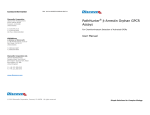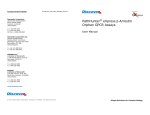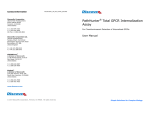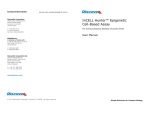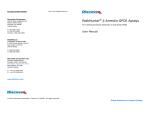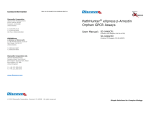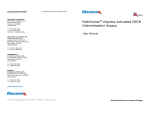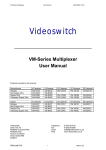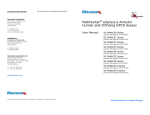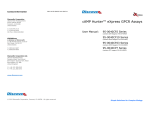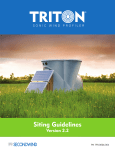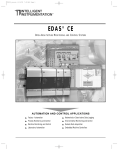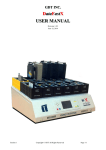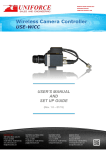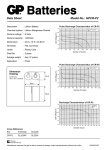Download PathHunter® β-Arrestin Orphan GPCR Assays
Transcript
PathHunter® β-Arrestin Orphan GPCR Assays For Chemiluminescent Detection of Activated GPCRs User Manual Simple Solutions for Complex Biology CONTENTS LEGAL SECTION PAGE 3 INTENDED USE PAGE 4 TECHNOLOGY PRINCIPLE PAGE 4 CHARACTERIZATION OF ORPHAN GPCR CELL LINES PAGE 5 ASSAY OVERVIEW PAGE 6 MATERIALS PROVIDED PAGE 6 RECOMMENDED MATERIALS PAGE 6 ADDITIONAL MATERIALS REQUIRED (NOT PROVIDED) PAGE 7 FROZEN CELL HANDLING PROCEDURE PAGE 7 CELL PLATING REAGENT REQUIREMENTS PAGE 8 SOLVENTS AND PREPARATION OF COMPOUND DILUTIONS PAGE 8 USE OF PLASMA OR SERUM CONTAINING SAMPLES PAGE 8 STORING & REMOVING CRYOVIALS FROM LIQUID NITROGEN PAGE 8 CELL THAWING AND PROPAGATION PAGE 9 CELL FREEZING PROTOCOL PAGE 10 PREPARATION OF ASSAY PLATES PAGE 11 ASSAY PROCEDURE — AGONIST DOSE RESPONSE PROTOCOL QUICK START PROCEDURE PAGE 11 PAGE 14 TROUBLESHOOTING GUIDE PAGE 15 APPENDIX A: ASSAY FORMATS PAGE 16 APPENDIX B: RELATED PRODUCTS PAGE 16 2 LEGAL SECTION This product and/or its use is covered by one or more of the following U.S. patents #6,342,345 B1, #7,135,325 B2, #8,101,373 B2 and/or foreign patents, patent applications, and trade secrets that are either owned by or licensed to DiscoveRx® Corporation. This product is for in vitro use only and in no event can this product be used in whole animals. The right to use or practice the inventions in the foregoing patents (including method of use claims) by using or propagating this product is granted solely in connection with the use of appropriate Detection Reagents (protected under trade secret) purchased from DiscoveRx Corporation or its authorized distributors. LIMITED USE LICENSE AGREEMENT The cells and detection reagents (collectively Materials) purchased from DiscoveRx are expressly restricted in their use. DiscoveRx has developed a Protein:Protein Interaction assay (Assay) that employs genetically modified cells and vectors (collectively, the ―Cells‖), and related detection reagents (the ―Reagents‖) (collectively referred to as ―Materials‖). By purchasing and using the Materials, the Purchaser agrees to comply with the following terms and conditions of this label license and recognizes and agrees to such restrictions: 1. The Materials are not transferable and will be used only at the site for which they were purchased. Transfer to another site owned by Purchaser will be permitted only upon written request by Purchaser followed by subsequent written approval by DiscoveRx. 2. The Reagents contain or are based upon the proprietary and valuable know-how developed by DiscoveRx, and the Reagents have been optimized by DiscoveRx to function more effectively with the Cells in performing the Assay. Purchaser will not analyze or reverse engineer the Materials nor have them analyzed on Purchaser’s behalf. 3. In performing the Assay, Purchaser will use only Reagents supplied by DiscoveRx or an authorized DiscoveRx distributor for the Materials. If the purchaser is not willing to accept the limitations of this limited use statement and/or has any further questions regarding the rights conferred with purchase of the Materials, please contact: Licensing Department DiscoveRx Corporation 42501 Albrae Street Fremont, CA 94538 USA tel | 1.510.979.1415 x104 [email protected] For some products/cell lines, certain 3rd party gene specific patents may be required to use the cell line. It is the purchaser's responsibility to determine if such patents or other intellectual property rights are required. 3 INTENDED USE PathHunter® β-Arrestin Orphan GPCR Assays are whole cell, functional assays that directly measure GPCR activity by detecting the interaction of β-Arrestin with the activated GPCR. Because Arrestin recruitment occurs independent of G-protein coupling, PathHunter β-Arrestin assays offer a powerful and universal screening platform that can be used for virtually any GPCR without knowing the coupling status of the receptor. The PathHunter system combines engineered clonal cell lines stably expressing the ProLinkTM (PK)- tagged GPCR of interest and the Enzyme acceptor (EA)-tagged β-Arrestin fusion protein with optimized PathHunter Detection Reagents (Cat. #93-0001, 93-0001L and 93-0001XL). By combining a simple, one -step addition protocol and standard chemiluminescent detection, these assays are ideally suited for surrogate ligand discovery, de-orphanization and compound profiling. TECHNOLOGY PRINCIPLE PathHunter β-Arrestin cell lines monitor GPCR activity by detecting the interaction of β-Arrestin with the activated GPCR using β-galactosidase (β-gal) enzyme fragment complementation (EFC, Figure 1). In this system, the GPCR of interest is fused in frame with the small, 42 amino acid fragment of β-gal called ProLink™ and co-expressed in cells stably expressing a fusion protein of β-Arrestin and the larger, N-terminal deletion mutant of β-gal (called enzyme acceptor or EA). Activation of the GPCR stimulates binding of β-Arrestin/EA to the ProLink-tagged GPCR and forces complementation of the two enzyme fragments, resulting in the formation of an active β-gal enzyme. This action leads to an increase in enzyme activity that can be measured using chemiluminescent PathHunter Detection Reagents. Because Arrestin recruitment occurs independent of G-protein coupling, these assays provide a direct, universal platform for measuring receptor activation. Figure 1. PathHunter® β-Arrestin Assay Principle. Activation of the ProLink-tagged GPCR results in β-Arrestin recruitment and formation of a functional enzyme capable of hydrolyzing substrate and generating a chemiluminescent signal. 4 CHARACTERIZATION OF ORPHAN GPCR CELL LINES PathHunter eXpress β-Arrestin Orphan GPCR cell lines are validated using the following criteria: a) Confirmation of proper oGPCR expression at the predicted molecular weight (Figure 2) and; b) In-vitro complementation studies to measure basal activity and GPCR-PK expression (Figure 3). Figure 2. Cell lysates prepared from PathHunter® β-Arrestin Orphan GPCR cell lines were treated with PNGase F (Glyko; Cat. #GKE-5003), run on a SDS-PAGE gel and analyzed using the EAstern Blot Assay Kit (DiscoveRx, Cat. # 93-0053). Untreated lane resolves a band of appropriate size corresponding to GPCR-PK fusion protein and the PNGase F treated lane resolves a deglycosylated band indicative of proper expression and folding of GPCR protein. Figure 3. PathHunter® β-Arrestin Orphan GPCR cells were analyzed for basal activity as well as GPCR-ProLink™ expression by comparing the ratio of signal between untreated cells and cells treated with saturating amounts of exogenous EA, using ProLink™ Detection Kit (DiscoveRx, Cat. # 920006). Signal from complementation of ProLink™ and EA fragments correlates to the amount of GPCR-PK expression in the cell line. 5 ASSAY OVERVIEW Please read the entire protocol completely before running the assay. Successful results depend on understanding and performing these steps correctly. The Assay Procedure sections and Quick Start Guides in this booklet contain detailed information about how to run the assays. Refer to the cell-line specific datasheet for additional information on the optimized Cell Plating Reagent and reference ligand recommended for the assay. Assays should be run using a fresh split of low-passage cells that have not been allowed to reach confluency for more than 24 hours. Following treatment of the cells with compound, GPCR activity is detected by adding a working solution of chemiluminescent PathHunter Detection Reagents using a simple, mix-and-read protocol. The following steps are required to monitor GPCR activity using a PathHunter β-Arrestin Orphan GPCR cell line (Figure 4). 1. Plate cells (page 11). 2. Dilute and add compounds. 3. Perform functional assay in agonist mode (page 11). Plate cells & add compounds Add PathHunter Detection Reagents Figure 4. Simple chemiluminescent assay protocol for monitoring GPCR activity in response to compound challenge. MATERIALS PROVIDED Description Contents PathHunter β-Arrestin Orphan Cell Line 2 vials Storage Liquid N2 (vapor phase) *Please refer to the cell line specific datasheet for detailed information on the PathHunter βArrestin Orphan GPCR cell line you are testing. RECOMMENDED MATERIALS The following materials are recommended: CytoTracker™ Cell Proliferation Kit (DiscoveRx, Cat. # 92-2001M) CytoTracker™ LDH Quantification Kit (DiscoveRx, Cat. # 92-2002) CytoTracker™ Glutathione Quantification Kit (DiscoveRx, Cat. # 92-2003) CytoTracker™ DNA Damage Quantification Kit (DiscoveRx, Cat. # 92-2004M) 6 ADDITIONAL MATERIALS REQUIRED (NOT PROVIDED) The following additional materials are required to perform PathHunter β-Arrestin Orphan GPCR Assays: Equipment Materials Green V-Bottom PP Ligand Dilution Plates, 10 plates/pack (DiscoveRx, Cat. #92-0011) 96-well Clear Bottom TC treated, Sterile WCB, FB w/lid, 10 plates/pack (DiscoveRx, Cat. #92-0014) PathHunter® Detection Kit (DiscoveRx, Cat. #93-0001, #93-0001L or #93-0001XL) AssayComplete™ Revive Media (DiscoveRx, Cat. #92-0016RM Series) AssayComplete™ Cell Culture Kit (DiscoveRx, Cat. #92-0018G Series) AssayComplete™ Preserve Freezing Reagent (DiscoveRx, Cat. #92-0017FR Series) AssayComplete™ Cell Detachment Reagent (DiscoveRx, Cat. #92-0009) AssayComplete™ Cell Plating (CP) Reagent (DiscoveRx, Cat. #93-0563R Series) Phosphate buffered saline (PBS) 384-well Clear Bottom TC treated, Sterile WCB, FB w/lid, 10 plates/pack (DiscoveRx, Cat. #92-0013) 384-well White Bottom TC treated, Sterile w/lid, 10 plates/pack (DiscoveRx, Cat. #92-0015) Disposable Reagent Reservoir (Thermo Scientific, Cat. #8094 or similar) Hemocytometer Cryogenic Freezing Container (Nalgene, Cat. #5100-0001 or similar) Cryogenic Freezer Vials (Fisher Scientific, Cat. #375418 or similar) Multimode or luminescence plate reader GPCR test ligands Single and multi-channel pipettors and pipette tips Tissue culture disposables and plastic ware (T25 and T75 flasks, etc.) ±Please refer to the cell line specific datasheet to determine catalog numbers for the media and reagent requirements for the PathHunter β-Arrestin Orphan GPCR cell line you are testing. FROZEN CELL HANDLING PROCEDURE To ensure maximum cell viability, thaw the vial and initiate the culture as soon as possible upon receipt. If continued storage of the frozen vials is necessary, store vials in the vapor phase of liquid nitrogen (N2). DO NOT store at –80°C as this could result in significant loss in cell viability. 7 CELL PLATING REAGENT REQUIREMENTS Each PathHunter β-Arrestin Orphan GPCR cell line has been validated for optimal assay performance using the recommended AssayComplete Cell Plating (CP) Reagent as indicated in the cell line specific datasheet. For optimal performance using this PathHunter Certified System, always use the AssayComplete CP Reagent recommended for the cell line and DO NOT substitute at any time. SOLVENTS AND PREPARATION OF COMPOUND DILUTIONS PathHunter β-Arrestin Orphan GPCR assays are routinely carried out in the presence of ≤ 1% solvent (i.e. DMSO, ethanol, PBS or other). As solvents can affect assay performance, optimize the assay conditions accordingly if other solvents or solvent concentrations are required. For preparation of test compounds, we recommend preparing the dilutions using the CP Reagent recommended for the cell line (containing the appropriate solvent). For antibodies or other compounds that may be sensitive to serum and/or other assay components, dilutions can be prepared in either Hanks Buffered Salt Solution (HBSS) + 10 mM HEPES + 0.1% Bovine Serum Albumin (BSA) or OptiMEM® + 0.1% BSA without affecting assay performance. USE OF PLASMA OR SERUM CONTAINING SAMPLES PathHunter β-Arrestin Orphan GPCR Assays can be run in the presence of high levels of serum or plasma without negatively impacting assay performance. Ligands can be prepared in neat, heparinized plasma and added directly to the cells (without further dilution, ie. 100% plasma in the well). After ligand stimulation, the samples should be removed and replaced with fresh AssayComplete CP Reagent before the addition of the PathHunter Detection Reagents. NOTE: EDTA anti-coagulated plasma samples do not give a positive response in the assay. Therefore, the choice of anti-coagulant treatment is very important. STORING & REMOVING CRYOVIALS FROM LIQUID NITROGEN Cells are shipped in 2 vials on dry ice and contain approximately 1 x 10 6 cells per vial in 1 mL of freezing medium. The following procedures are for safely storing and removing cryovials from liquid nitrogen storage. 1. PathHunter cells must arrive in a frozen state on dry ice. thawed, do not proceed, contact technical support. 2. Frozen cells must be immediately transferred to liquid N2 storage or thawed and put in culture immediately upon arrival. 8 If cells arrive 3. When removing cryovials from liquid N2 storage, use tongs and place immediately on dry ice in a covered container. Wait at least one minute for any liquid N2 inside the vial to evaporate. 4. Proceed with the thawing protocol in the following section. SAFETY WARNING: A face shield, gloves and lab coat should be worn at all times when handling frozen vials. Some cryovials can leak when submerged in liquid N 2. Upon thawing, the liquid N2 present in the cryovial converts back to its gas phase which can result in the vessel exploding. CELL THAWING AND PROPAGATION The following procedures are for thawing, seeding and expanding the cells, and for maintaining the cultures once the cells have been expanded. Cells are free of contamination prior to shipment and care should be taken in their handling to avoid contamination. NOTE: Face shield, gloves and a lab coat should be worn during the thawing procedure. 1. Pre-warm 15 mL AssayComplete Revive Media in a 37°C water bath. 2. Place the frozen cell vials briefly (10 seconds to 1 min) in a 37°C water bath under sterile conditions until only small ice crystals remain and the cell pellet is almost completely thawed. Caution: Longer incubation may result in cell death. 3. To remove DMSO from the media, carefully transfer the thawed cells to a sterile 15 mL tube and then fill tube with 10 ml pre-warmed AssayComplete Revive Media. Centrifuge at 300 x g for 4 minutes to pellet cells. 4. Remove media without disturbing cell pellet and resuspend in 5 mL of prewarmed AssayComplete Revive Media. Transfer cells to a T25 flask and incubate for 24 hours at 37°C, 5% CO2. NOTE: Cell recovery is greatly improved when selection antibiotics are omitted for the first 24 hours. 5. After 24 hours, gently remove AssayComplete Revive Media (being careful not to disturb the cell monolayer) and replace with 5 mL of pre-warmed complete AssayComplete Cell Culture Media. 6. Once the cells become >70% confluent in the T25 flask, aspirate media and wash cells with 5 mL PBS. Aspirate PBS and dissociate cells with 0.5 mL AssayComplete Cell Detachment Reagent and resuspend in 5 mL of AssayComplete Cell Culture Media. Transfer the entire cell suspension to a T75 flask containing 15 mL of AssayComplete Cell Culture Media for continued growth. 9 7. Passage the cells every 2-3 days, based on the doubling time of the cell line, using AssayComplete Cell Detachment Reagent. For routine passaging, prepare a 1:3 dilution of cells in a total volume of 15 mL AssayComplete Cell Culture Media. Transfer 5 mL of the diluted cells to each new T75 flask. NOTE: To maintain logarithmic growth of the cells, cultures should be maintained in a subconfluent monolayer. 8. Each PathHunter β-Arrestin Orphan GPCR Cell Line has been found to be stable for at least 10 passages with no significant drop in expression level. CELL FREEZING PROTOCOL The following procedures are for freezing cells from confluent T225 flasks. If smaller flasks are used, adjust the volumes accordingly. Care should be taken in handling to avoid contamination. 1. Remove T225 flasks from incubator and place in the tissue culture hood. Aspirate the media from the flasks. 2. Add 10 mL PBS into each T225 flask and swirl to rinse the cells. Aspirate PBS from flask. 3. Add 5 mL of AssayComplete Cell Detachment Reagent to the flask. Rock the flask back and forth gently to ensure the surface of the flask is covered. Incubate at 37°C, 5% CO2 for 2–5 minutes or until the cells have detached. 4. Remove the flask from the incubator and view under a microscope to confirm that the cells have detached. If necessary, tap the edge of the flask to detach cells from the surface. 5. Add 8–10 mL of AssayComplete Revive Media to each T225 flask. Rinse the cells from the surface of the flask using the added media. Remove the cells from the flask and transfer to a 50 mL conical tube. (If necessary, add an additional 5 mL of media to the flask and rinse to collect the remaining cells and transfer the additional volume to the 50 mL conical tube). Remove 0.5 mL of the resuspended cells and count the cells using a hemocytometer. Centrifuge the collected cells at 300 x g for 4 minutes. 6. 7. After centrifugation, discard the supernatant. Resuspend the cell pellet in AssayComplete Preserve Freezing Reagent. Based on the cell number obtained from Step 5, dilute the resuspended cells to a concentration of 1.2 X 106 cells/mL using AssayComplete Preserve Freezing Reagent. 8. Transfer 1 mL cells to each 2 mL cryogenic tube. (Keep cells on ice during this process and transfer to a cryogenic container pre-chilled at 4°C). 9. Transfer tubes to –80°C and store overnight. Transfer tubes into the vapor phase of a liquid N2 tank for long-term storage. 10 PREPARATION OF ASSAY PLATES Each PathHunter β-Arrestin Orphan GPCR Assay has been validated for optimal assay performance using the specific AssayComplete Cell Plating Reagent. Always use the AssayComplete CP Reagent recommended for the cell line and DO NOT substitute at any time. 1. Harvest the cells as follows from a confluent T25 or T75 flask using AssayComplete Cell Detachment Reagent. Do not use trypsin. a) Remove AssayComplete Cell Culture Media. b) Gently wash cells with 5 mL PBS and aspirate. c) Add 0.5 mL AssayComplete Cell Detachment Reagent to each T25 flask, or 1 mL to each T75 flask. d) Place the flask in the incubator for 5 minutes or until cells have detached. e) Add 3 mL of AssayComplete CP Reagent and transfer to a 15 mL conical tube. 2. Determine the cell density using a hemocytometer. Centrifuge the cells at 300 x g for 4 minutes to pellet cells. Remove supernatant. 3. Resuspend cells in AssayComplete CP Reagent at a concentration of 250,000 cells/mL (5,000 cells/20 μL). Transfer 20 μL of the cell suspension to each well of a 384-well microplate. Please refer to Appendix A for cell numbers and volumes for alternate formats. 4. Incubate the plate overnight at 37°C, 5% CO2. ASSAY PROCEDURE — AGONIST DOSE RESPONSE CURVE 1 Compound 1 Compound 3 Compound 5 Compound 7 Compound 9 Compound 11 Compound 13 Compound 15 Low 2 3 3-fold serial dilutions of agonist 4 5 6 7 High No agonist No agonist The steps outlined below provide the assay volumes and procedures for performing GPCR agonist assays using the PathHunter β-Arrestin Orphan GPCR Cell Lines and PathHunter Detection Reagents in a 384-well format. Refer to Appendix A for cell numbers and volumes for alternate formats. Although plate layouts and experimental designs may vary, we recommend performing a 12-point dose curve for each compound using at least duplicate wells for each dilution. Low 3-fold serial dilutions of agonist High 8 9 10 11 12 13 14 15 16 17 18 19 20 21 22 23 24 A B C D E F G H I J K L M N O P Compound 2 Compound 4 Compound 6 Compound 8 Compound 10 Compound 12 Compound 14 Compound 16 Figure 5. This plate map shows 12-point dose curves with 2 data points at each concentration. Plate map allows 16 compounds to be tested in duplicate per 384-well plate. 11 DAY 1: PREPARATION OF ASSAY PLATES Plate PathHunter cells in the appropriate number of wells in a 384-well plate as described in the ―Preparation of Assay Plates‖ section on page 11. Allow cells to incubate overnight. DAY 2: AGONIST COMPOUND PREPARATION AND ADDITION 1. Dissolve agonist compound in the vehicle of choice (DMSO, ethanol, PBS or other) at the desired stock concentration. 2. Prepare a series of twelve 3-fold serial dilutions of agonist compound in AssayComplete CP Reagent containing the appropriate solvent (DMSO, ethanol, PBS or other) as described below. The concentration of each dilution should be prepared at 5X of the final screening concentration (i.e. 5 µL compound + 20 µL of cells). For each dilution, the final concentration of solvent should remain constant. a) For each compound tested, label the wells of a 384-well dilution plate #1 through #12. b) Add 20 µL of AssayComplete CP Reagent containing appropriate solvent to wells #1-11. c) Prepare a working concentration of agonist compound in the appropriate AssayComplete CP Reagent. d) Add 30 µL of the working concentration of agonist compound to well #12. e) Remove 10 µL of compound from well #12, add it to well #11 and mix gently by pipetting up and down. Discard pipet tip. f) With a clean pipet tip, remove 10 µL of diluted compound from well #11, add it to well #10 and mix gently by pipetting up and down. Discard the pipet tip. g) Repeat this process 8 more times in succession to prepare serial dilutions for the remaining wells, from right to left across the plate. DO NOT add agonist compound to well #1. This sample serves as the no agonist control and completes the dose curve. h) Repeat this process for each additional agonist compound to be tested. i) Set compounds aside until agonist compounds are ready to be added. 3. Remove PathHunter cells from the incubator (previously plated on day 1). 4. Transfer 5 µL from wells #1–12 to duplicate wells according to the plate map shown on page 11. 5. Incubate for 90 minutes @ 37°C. 12 SUBSTRATE PREPARATION AND ADDITION 1. Prepare PathHunter Detection Reagent by combining 1 part Substrate Reagent 2 with 5 parts Substrate Reagent 1, and 19 parts of Cell Assay Buffer. Component Entire Plate (384 wells) Cell Assay Buffer 4.75 mL Substrate Reagent 1 1.25 mL Substrate Reagent 2 0.25 mL NOTE: The working solution is stable for up to 8 hours at room temperature. 2. Add 12 μL of prepared detection reagent to the appropriate wells. DO NOT pipet up and down in the well to mix or vortex/shake plates. 3. Incubate for 60 minutes at room temperature (23°C). 4. Read samples on any standard luminescence plate reader. 5. Use GraphPad Prism® or other comparable program to plot your agonist dose response. See the example shown in Figure 6. REPRESENTATIVE DATA AND DATA ANALYSIS Figure 6. PathHunter® CHO-K1 GPR35 β-Arrestin Cells (93-0355C2). (A) Expression of the GPR35 receptor was analyzed by EAstern Blot, as shown by the presence of a 34 kD band (lane 3). (B) Cells were plated in a 384-well plate at 5,000 cells/well and stimulated with Zaprinast (DiscoveRx, Cat. #92-1048) for 90 minutes. Signal was detected using the PathHunter Detection Kit (93-0001) according to the recommended protocol. 13 QUICK-START PROCEDURE: AGONIST DOSE RESPONSE Plate 20 µL PathHunter cells per well Incubate overnight @ 37°C Add 5 µL of agonist Incubate 90 minutes @ 37°C Add 12 µL Detection Reagent Working Solution Incubate 60 Minutes @ Room Temperature Read Chemiluminescent Signal 14 TROUBLESHOOTING GUIDE PROBLEM No Response Decreased Response Low or No Signal Cells growing slowly CAUSE SOLUTION Improper cell growth conditions See Product Insert for cell culture conditions High DMSO/solvent concentration Maintain DMSO/solvent at <1% in serial dilutions of compounds. Improper ligand used or improper ligand incubation time See Product Insert for recommended ligand and assay conditions Improper preparation of ligand Refer to vendor specific datasheet to ensure proper handling, dilution and storage of ligand Improper time course for induction Optimize time course of induction with agonist and antagonist. Higher passages give reduced performance PathHunter cells are stable up to 10 passages. Use low passage cells whenever possible Cells are not adherent and exhibit incorrect morphology Confirm adherence of cells using microscopy Improper preparation of detection reagents Detection reagents should be prepared just prior to use and are sensitive to light. Problem with cell growth, cell viability, cell adherence or cell density See Product Insert for cell culture conditions. Problem with micro plate reader Micro plate reader should be in luminescence mode. Read at 1 sec/well. U2OS grow slower than CHO-K1 or HEK 293 Average doubling time is 3 days, so please observe cells under microscope and monitor cell health Slow growing clones Use of DiscoveRx functionally validated and optimized media and reagents improves assay performance For additional information or technical support, please call 1.866.448.4864 (US) +44.121.260.6142 (Europe) or email [email protected] 15 APPENDIX A: ASSAY FORMATS PathHunter® Certified Assay Format Plate Format 96-well FV 384-well LV 384-well 1536-well Total Volume 150 μL 40 μL 20 μL 8 μL Cell Numbers 10,000 5,000 2,500 1,250 Cell Plating Reagents* 90 μL 20 μL 10 μL 4 μL Ligand 10 μL 5 μL 2.5 μL 1 μL Detection Reagents 50 μL 12 μL 6 μL 3 μL *Cell Plating Reagent volume used to resuspend cells for assay plates APPENDIX B: RELATED PRODUCTS Description Ordering Information Control Ligands www.discoverx.com/pathway_assays/control_ligands.php AssayComplete™ Cell Plating Reagent www.discoverx.com/certified/cell_plating_reagents.php www.discoverx.com/certified/PH_cell-culture_reagents.php AssayComplete™ Cell Culture Kit AssayComplete™ Revive Media AssayComplete™ Preserve Freezing Reagent PathHunter® Detection Reagents www.discoverx.com/certified/PH_detection_reagents.php Microplates www.discoverx.com/certified/microplates.php PathHunter® eXpress β-Arrestin GPCR Assays www.discoverx.com/gpcrs/express_arrestin.php PathHunter® eXpress β-Arrestin Orphan GPCR Assays www.discoverx.com/gpcrs/express_orphan.php PathHunter® eXpress β-Arrestin Ortholog GPCR Assays www.discoverx.com/gpcrs/express_ortholog.php 16 NOTES: 17 NOTES: 18 NOTES: 19 Contact Information 70-248 DRx_UM_PH_ARR_ORPHAN_0914V6 DiscoveRx Corporation (World Wide Headquarters) 42501 Albrae Street Fremont, CA 94538 United States t | 1.510.979.1415 f | 1.510.979.1650 toll-free | 1.866.448.4864 DiscoveRx Corporation Ltd. (Europe Headquarters) Faraday Wharf, Holt Street Birmingham Science Park Aston Birmingham, B7 4BB United Kingdom t | +44.121.260.6142 f | +44.121.260.6143 KINOMEscan® A division of DiscoveRx 11180 Roselle Street, Suite D San Diego, CA 92121 United States t | 1.800.644.5687 f | 1.858.630.4600 BioSeek® A division of DiscoveRx 310 Utah Avenue, Suite 100 South San Francisco, CA 94080 United States t | 1.650.416.7600 f | 1.650.416.7625 www.discoverx.com © 2014 DiscoveRx Corporation, Fremont, CA 94538. All rights reserved.




















